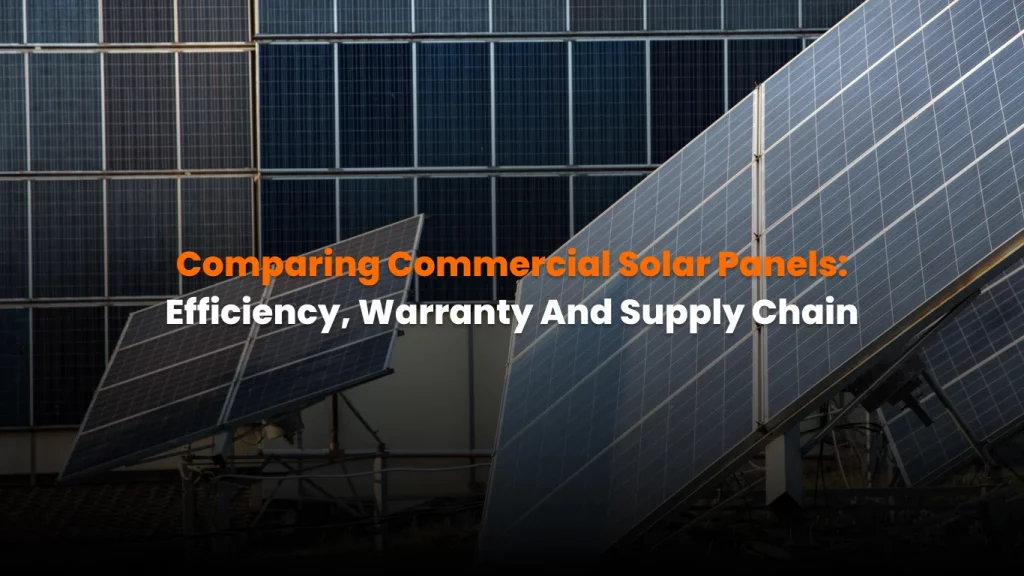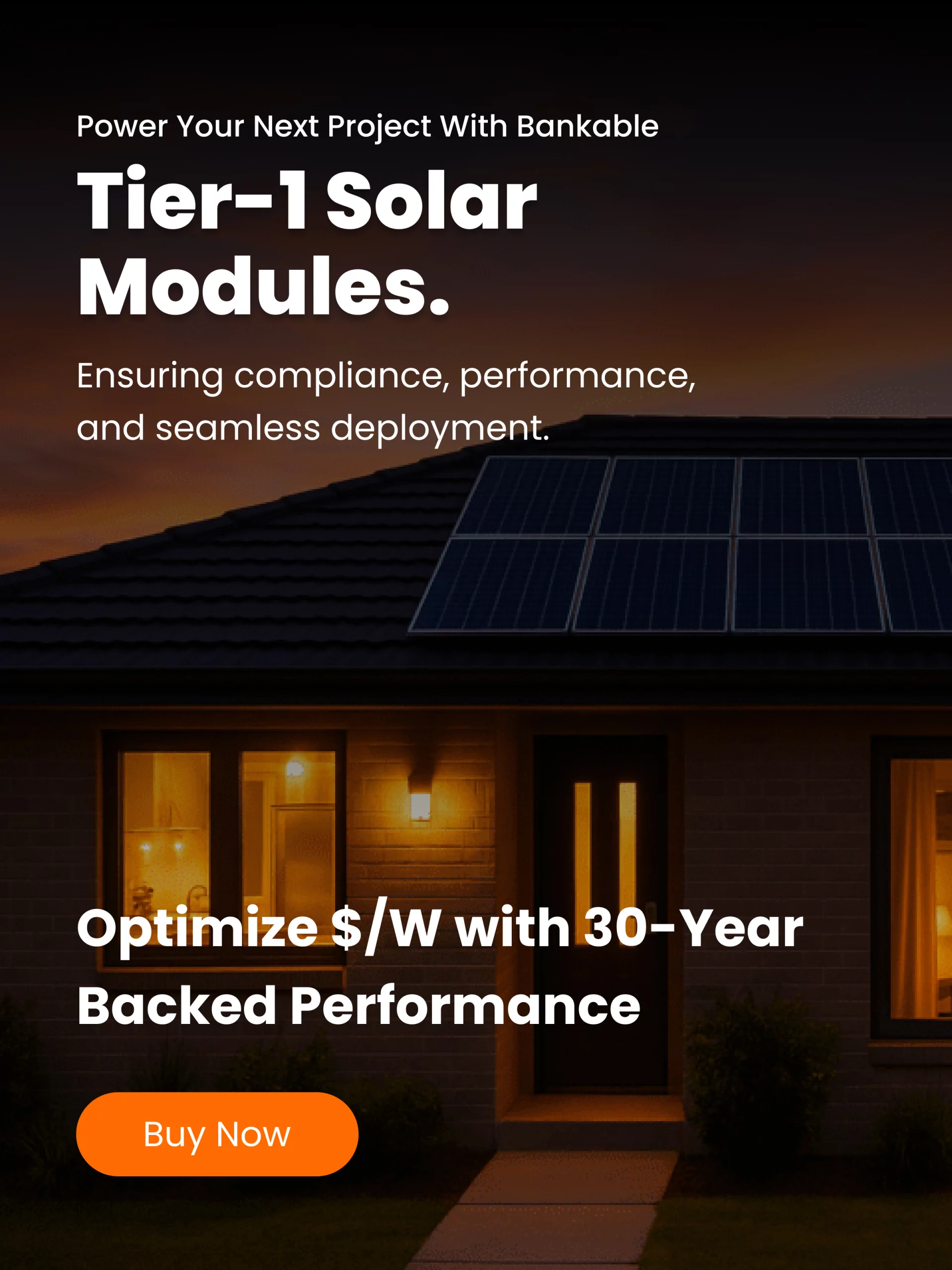Investing in the right commercial solar panels can make or break the economics of a large scale project. Businesses must weigh efficiency, warranty terms and supply chain considerations alongside price. The U.S. commercial solar segment added 486 MWdc of capacity in the first quarter of 2025, a 4 percent increase over Q1 2024. Growth has been driven by projects in California under the net energy metering 2.0 program. Yet developers face headwinds from policy uncertainty and tariffs that could slow the market later in the decade. Meanwhile, module prices have climbed due to trade investigations, but technological advances like Tunnel Oxide Passivated Contact (TOPcon) cells have helped lower overall system costs. To navigate these dynamics, this article compares leading commercial solar modules and offers procurement tips for bulk purchasers.
Evaluating Efficiency and Output
Efficiency measures how much of the sunlight hitting a panel is converted into electricity. Higher efficiency means more watts per square meter, allowing projects to maximize output on rooftops or constrained land. Lower efficiency modules may still be suitable where space is abundant, but they require more racking and labor. Listed below are some of the most efficient panels available for commercial buyers in 2025:
| Panel | Power Rating | Maximum Efficiency | Warranty | Key Features |
|---|---|---|---|---|
| SunPower M series (commercial) | 450–475 W | Up to 22.3 percent | 25 year product and performance warranty | Utilizes 72 Maxeon Gen 6 cells; designed for the Helix system; copper foundation resists breakage; high energy output |
| REC Alpha Pure RX | 450–470 W | Up to 22.6 percent | 25 year product and performance warranty; module retains at least 92 percent of its rated power in year 25 | Heterojunction technology (HJT) cells; RoHS compliant lead free design; manufactured by REC in Singapore |
| Q Cells Q.Tron BLK M G2+ | 435 W | Up to 22.5 percent | 25 year product and 25 year linear performance warranty | N-type Q.ANTUM NEO cells with zero gap layout; certified under TÜV Rheinland’s Quality Controlled PV program; designed to withstand 8,100 Pa snow loads and 3,600 Pa wind loads |
| Mission Solar N type 435 W module | 435 W | 22.8 percent | 30 year power warranty; product is compliant with U.S. domestic content requirements | Incorporates multi-busbar design to reduce resistance and improve current flow; qualifies for domestic content incentives; free from anti-dumping and countervailing duty tariffs |
| Canadian Solar HiDM All-Black | 320–340 W | Up to 20.4 percent | 15 year product warranty and 25 year linear performance warranty | Shingle PERC cells with improved shading tolerance and low temperature coefficient; features enhanced reliability with LeTID less than 2 percent |
The table shows that premium panels from SunPower, REC and Q Cells achieve efficiencies above 22 percent and offer robust warranties. Mission Solar, a U.S. manufacturer, provides an industry leading 22.8 percent efficiency and a thirty year power warranty. Canadian Solar’s HiDM modules are less efficient but still provide solid performance with a 25 year power guarantee.
Warranty Terms and Long Term Reliability
Warranty coverage protects buyers against premature failure and performance degradation. Product warranties cover defects, while performance warranties guarantee a minimum power output after a certain number of years. SunPower and REC provide 25 year product and performance warranties. Q Cells matches this coverage and adds independent quality control certification. Mission Solar goes further with a 30 year power warranty. Canadian Solar’s HiDM modules offer a shorter 15 year product warranty but still promise 25 year performance.
Degradation rates also matter. Heterojunction and N type cells, used by REC and Mission Solar, have lower degradation than P type cells found in some older modules. For example, REC guarantees at least 92 percent of rated power after 25 years, while Q Cells promises 90.58 percent after 25 years. SunPower’s Maxeon technology features a solid copper backing that resists cracks and corrosion, helping maintain performance.
Supply Chain and Procurement Considerations
Selecting commercial panels is not only about specifications. Supply chain reliability, domestic content and pricing trends also influence decisions:
- Domestic manufacturing capacity is growing. In 2024 U.S. manufacturers increased module production from 14.5 GW to 42.1 GW, a 190 percent jump that meets most domestic demand. Buying from domestic producers like Mission Solar or U.S.-assembled Q Cells panels can reduce exposure to import tariffs and logistics delays.
- Prices remain volatile. Module prices rose 2–5 percent in early 2025 due to trade investigations and preliminary antidumping and countervailing duty determinations. Nevertheless, commercial system prices declined by 2 percent year over year to $1.47/Wdc thanks to efficiency improvements and cost saving measures. Buyers who lock in contracts early may avoid future increases.
- Technology adoption drives savings. Most new commercial projects now use TOPcon modules, which offer higher efficiency and help offset rising module prices. Panels with heterojunction and N type cells also provide better temperature coefficients and lower degradation.
- Policy and incentives matter. The commercial market may contract after the surge of California NEM 2.0 projects. However, developers expect growth to resume later in the decade as electricity rates rise and emerging state markets open. Buyers should monitor federal tax credits and domestic content bonuses that can improve project economics.
Procurement Tips for Bulk Buyers
When sourcing panels in bulk, distributors and installers should adopt a disciplined procurement process:
- Vet suppliers thoroughly. Confirm that manufacturers provide the certifications listed above, including UL and IEC standards, and verify warranty terms and financial stability.
- Compare total cost of ownership. Factor in installation labor, racking, shipping and any savings from higher efficiency. Sometimes a more expensive panel delivers better value because it reduces the number of modules required.
- Plan inventory around lead times. Domestic supply reduces transit time, but production schedules can still be lengthy. Align orders with project timelines and consider multiple suppliers to mitigate delays.
- Leverage economies of scale. Purchasing by the pallet or container often yields lower per-watt pricing, especially with Q Cells and Canadian Solar modules that are widely available.
- Stay informed on trade policies. Monitor tariffs and antidumping decisions that affect modules from Southeast Asia. Domestic manufacturers like Mission Solar may benefit from policy incentives and stable pricing.
Conclusion
The commercial solar market is evolving quickly as technological advances, domestic manufacturing and policy changes reshape the landscape. Choosing the right panel requires balancing efficiency, warranty protection and supply chain reliability. Premium modules from SunPower, REC and Q Cells offer efficiencies above 22 percent and comprehensive 25 year warranties. Mission Solar pushes efficiency to 22.8 percent while offering a thirty year power warranty. Canadian Solar’s HiDM panels provide a more budget friendly option with solid performance and a 25 year power guarantee. By weighing these factors buyers can make informed procurement decisions.




